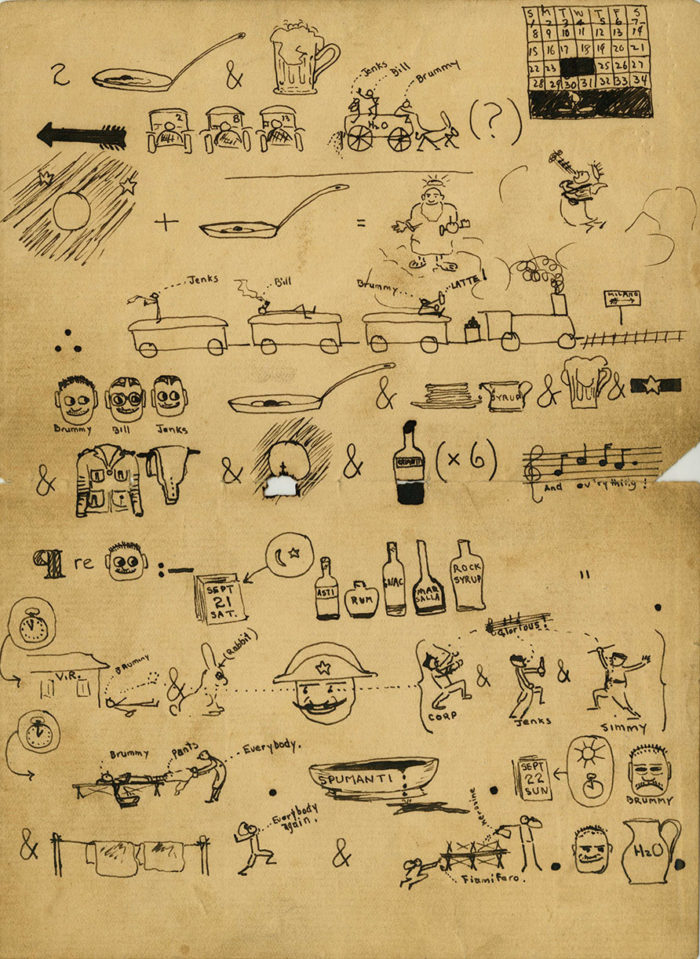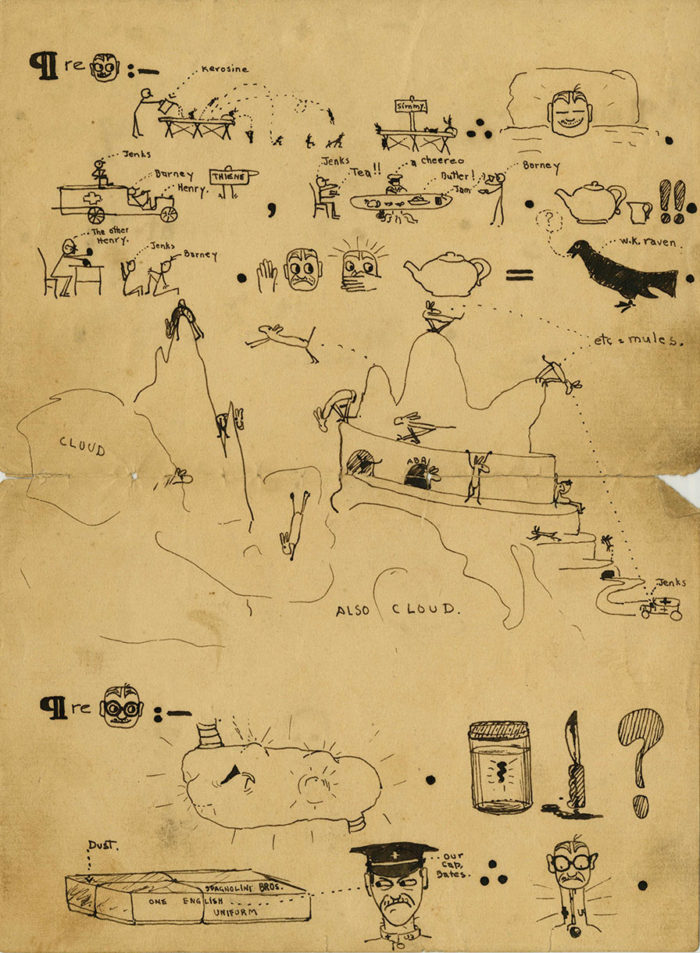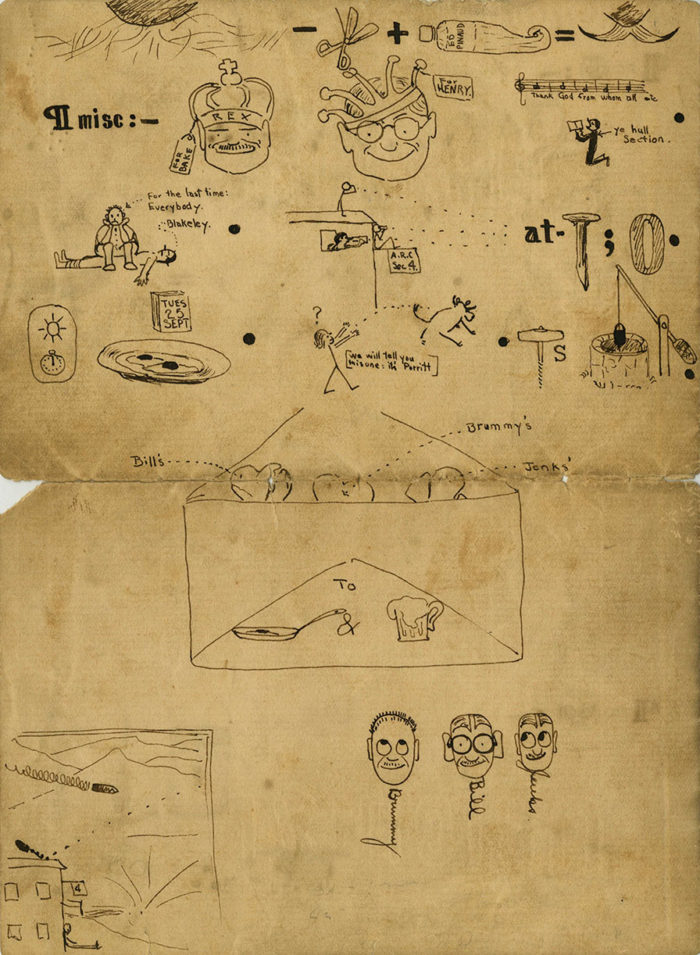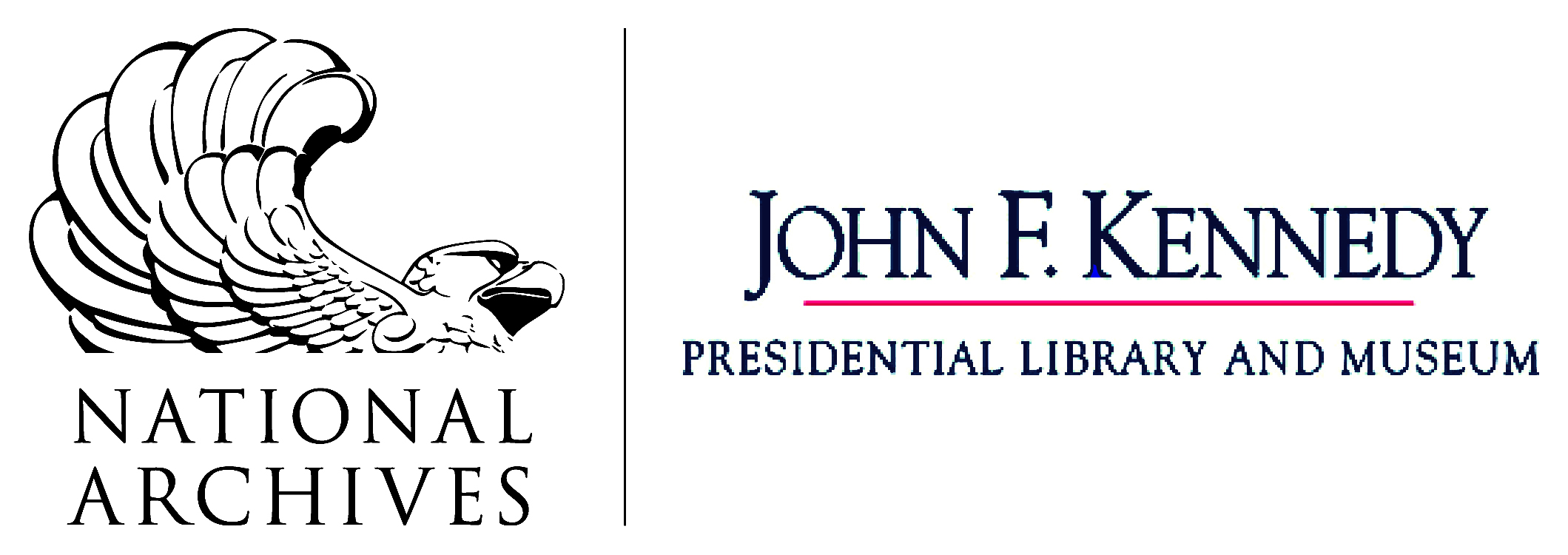(This post was published on our previous blog on 10/19/2012.)
By Jessica Green, Former Graduate Student Intern (Simmons University)
The Ernest Hemingway Collection at the John F. Kennedy Presidential Library and Museum is extremely grateful for all of the hard work our Hemingway aficionados put into deciphering this pictogram puzzle. Special thanks go out to Noah Kim and Ellen Knodt for their correct ordering of the document and narrative of the paragraphs. The following narrative is heavily based on William McFarland’s detailed description of each of these paragraphs, to whom we are very thankful. More thanks go out to Peter Krynicki, Marian Simmons, Robert W. Trogdon, Frank DeMarco, Elizabeth, David Anderson, Daniel Robinson, and “Fin” for their helpful ideas and for getting the discourse going. To see all of their insightful interpretations and detailed commentary, please see the comments under the original blog post: Hemingway Pictogram Puzzle.
Thanks to everyone’s help, we have put together the following (tentative) narrative of the whole document, so you can follow along with the images in the pictogram. We believe this document was a letter sent to Hemingway from his fellow American Red Cross (ARC) Section IV ambulance drivers, Brummy (Theodore B. Brumback), Bill (William D. Horne), and Jenks (Howell G. Jenkins), while he was recuperating at the American Red Cross hospital in Milan. His nurse was Agnes von Kurowsky, the model for Catherine Barkley in A Farewell to Arms.
The letter has been cataloged in the Ernest Hemingway Personal Papers in the Incoming Correspondence series. With the help of a perpetual calendar, the letter has been dated c. 24 September 1918, with copies filed under each one of the senders: Theodore B. Brumback, William D. Horne, and Howell G. Jenkins.



Greeting
To Agnes von Kurowsky (a frying pan with an egg, Ag sounds like egg) and Ernest Hemingway (overflowing beer stein, Hemingstein was a common nickname and this was a symbol used by Hemingway for himself).
Opening Paragraph
Yesterday, the three Fiat ARC ambulances driven by Brummy, Bill, and Jenks (numbers 2, 8, 13) sat idle, because there was nothing for them to do. Instead, the three ambulance drivers used the water wagon to sprinkle water on dirt roads in an effort to keep down the dust. They wanted to get out of doing such boring chores by obtaining permission to take some leave time. This possibility remained uncertain, however (question mark). They also knew that beautiful starry nights in Milan with Agnes were like heaven. Therefore, they wanted to leave Schio and travel by train to Milan. Upon arriving at the ARC Hospital, the three men would be joined by Agnes, ARC nurse Ruth “Brooksie” Brooks (pancakes and syrup = stacked and sweet), Hemingway, and Johnny Miller, Jr. (a ribbon bar signifies the Silver Medal of Valor both he and Hemingway received). They would change into their clean English-style uniforms and later that night the group would drink six bottles of Chianti and have fun with music and “ev’rything.”
Paragraph regarding Brummy
On Saturday, Sept. 21st, Brummy and his friends spent the night drinking mixed drinks made from Asti Spumanti, Rum, Cognac, Marsala, and Rock Syrup (water supersaturated with sugar) and enjoyed music and “ev’rything” (ditto marks). At 11:00 pm that night, Brummy, holding a bottle, passed out outside the V.R. (Villa Rosa brothel), where he was attended and protected by a V.R. worker (rabbit). At the same time, three members of ARC Section IV, Corp (Carleton Shaw), Jenks, and Simmy (Zalmon K. Simmons, Jr.) were drinking, singing, and marching around like drum majors (Corp with a cane, Jenks with a bottle, and Simmy with a baton). All of this activity was closely observed by an Italian carabinieri (national paramilitary policeman wearing a tricorn hat), who was slightly amused. By 1:00 am, Brummy was in such bad shape that “everybody” had to help him to his bed where they pulled off his pants and got him ready for bed. During the night, Brummy was so sick that he overfilled his “chamber pot,” labeled Spumanti (“spew-manti”?) At 10:00 am the next day, Brummy awakened with a horrible hangover, and could hardly open his eyes in the harsh daylight. In the night, he had soiled his sheets and bed, so “everybody again,” holding their noses, hung Brummy’s sheets outside on the clothesline to air out. Brummy’s cot was so badly soiled that two of the men, still holding their noses, poured kerosene on it and set it ablaze using a “fiamifaro” (fiammifero or wooden match). After drinking lots of water, Brummy felt much better, was able to fully open his eyes, and even smiled.
Paragraph regarding Jenks
Jenks treated his bed with kerosene to get rid of bedbugs, which promptly dove off his bed and migrated to Simmy’s bed. Jenks then slept soundly with a big smile. Jenks and fellow ARC ambulance driver Barney (Lawrence T. Barnett) drove a Ford Model T ambulance (nicknamed “Henry,” probably after Henry Ford) to Thiene. There they had tea, butter, and jam with a British person (a cheereo [sic], because he said “cheerio”). Despite the war, they were able to have real milk or cream in their tea. The other Henry severely reprimanded Jenks and Barney for making their unauthorized trip to Thiene, shaking his fist while pointing to rules and regulations laid out on his desk. Jenks and Barney pleaded with Henry for leniency. Jenks swore off tea saying the w.k. (well-known) “nevermore” of Edgar Allen Poe’s raven, but Barney only fumed with anger and refused to make any promises (hand over mouth). Later, Jenks, wanting to get away from the Section IV barracks, or perhaps following orders, took an ambulance high up above the clouds of Mount Pasubio (characterized by a tunnel, of which there were 52, as well as caves and a winding road). His fast and erratic driving scared lots of mules. They hid in caves, pressed themselves against the walls of the mountain, or jumped off the mountain in fear, only to be impaled on nearby mountaintops. Jenks may have planned to visit the cave with the sign “ABRI” (French for “shelter”). This shelter perhaps referred to the soup kitchen on Mount Pasubio.
Paragraph regarding Bill
Bill had been suffering from gastroenteritis and wondered whether he needed to have surgery to remove his appendix. “Our Cap Bates” (Captain Robert W. Bates, head of the ARC Ambulance Service in Italy) was not pleased when he saw that Bill had received a package in the mail from Spagnolini Bros (Milan tailor) that contained a new English-style officer’s uniform. Captain Bates ordered Bill to follow regulations and wear the regulation ARC Ambulance uniform. Bill wore the regulation uniform but he was very displeased and quite uncomfortable with the high, tight collar. Bill’s mustache had grown too long and was unruly, so he trimmed it with scissors and added Ed Pinaud’s wax. The result was a beautiful mustache with waxed, turned-up ends.
Paragraph Misc (Miscellaneous)
Two men from ARC Section IV, “Bake” (1st Lt. Edwin H. Baker, Jr.) and “Henry” (2nd Lt. William H. “Henry” George) were honored with crowns for the dedicated leadership they displayed during the recently-ended Battle of the Piave. The “ye hall section” praised them with prayers and singing, including the doxology song (“Praise God from whom all things” etc.), an integral part of many Protestant worship services. Everyone was tired of waiting for (sitting on) fellow ARC Section IV member Blakeley (G. Bogert Blakeley), who always ran late for every activity. They decided that they’d waited for Blakeley “for the last time.” Members of Section IV had been anticipating and looking out for an attack, but so far, there had been no such attack (big zero). At noon on Tuesday (actually Wednesday), Sept. 25th, they had fresh eggs for lunch (a treat always worth mentioning). ARC Section IV member, Porritt (Longshaw K. Porritt), who had been overly quiet in the past, seemed much improved at lunch, bragging and telling tall tales (throwing a bull). It augured well (is a good omen, for Porritt to be more outgoing and assertive).
Complimentary Closing
To Agnes and Hemingway, with love from Bill, Brummy, and Jenks.
Senders’ “Signatures”
Drawings of Brummy, Bill, and Jenks together with their names.
Senders’ Address
A drawing of the Section IV building at the bottom left corner of page three is the equivalent of a “sender’s address” sometimes put at the end of a letter. The Section IV building served as Section IV headquarters and barracks and was located near Schio, Italy, not far from Mount Pasubio. Artillery shells are depicted flying through the air to indicate that this location is near the front lines. A skeleton is depicted slumped against the front of the building probably denoting that there is little activity at present and times are boring — or perhaps indicating the danger associated with their location.

Which begs the question – what happened to these hilarious, rambunctious, and creative troublemakers? We want to know what happened to Brummy, Bill, and Jenks!
A very clever group of folks w/ Hemingway in Italy . His time was very brief (May 1917 until Jan.1919) and his exploits truncated by his wounds. I had always imagined he’d spent many years in Italy. His exposure to the horrors of war and the after effects would haunt him all of his 62 years. Hemingway was 18 when he went to Italy (his sight problems kept him from military service). It is very easy to imagine the after effects of his time as an ambulance driver stayed w/ him in the form of depression throughout his years.
The rebus from his friends was very clever.
[…] post has been migrated to our newer blog. Click here to see […]
[…] author Ernest Hemingway. Both Hemingway and Porritt wrote essays for their unit newspaper, Ciao. A creative letter to Hemingway from this time even mentions Longshaw’s recovery from a bout of depression, evinced by his telling tall […]